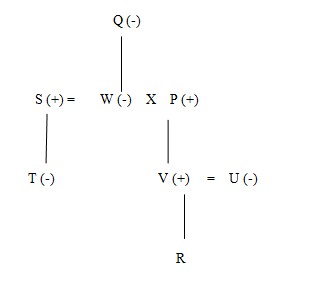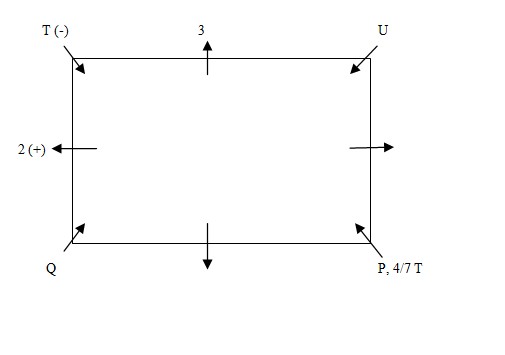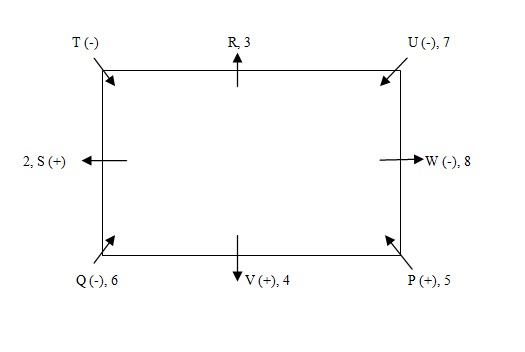Question
How is U related to
Q? Read the following information carefully and answer the questions given below it: P, Q, R, S, T, U, V and W are sitting around a square table in such a way that four of them who sits at the corner are facing towards the centre and other four who sits in the middle of the table are facing outside the centre. Each person has different number of coins viz. 1, 2, 3, 4, 5, 6, 7 and 8, but not necessarily in the same order. Only one person sits between W and V. V sits second to the right of the person who has 8 coins. W’s brother S, sits on the immediate left of his mother who has 6 coin. P is the father of V and only one person sits between W’s mother and T. S’s daughter sits second to the right of U and on the immediate left of that person who has 3 coins. Q sits second to the left of W’s husband who has neither 4 nor 7 coins. U, who is sister of V, has 7 coins and is not an immediate neighbour of W’s husband. T sits on the immediate right of the person who has 2 coins. S’s daughter has 1 coin. Only one person is sitting between P and U. No female is an immediate neighbour of Q, who sits at the corner of the table. V is father of R and is not an immediate neighbour of T. P is married to W.Solution
W’s brother S, sits on the immediate left of his mother who has 6 coins. P is the father of V and only one person sits between W’s mother and T. U, who is sister of V, has 7 coins and is not an immediate neighbour of W’s husband. V is father of R and is not an immediate neighbour of T. P is married to W. By the statement ‘only one person sits between W’s mother and T’, we find that Q is W’s mother and T is S’ daughter.  No female is an immediate neighbour of Q, who sits at the corner of the table. Q sits second to the left of W’s husband who has neither 4 nor 7 coins. Only one person is sitting between P and U. S’s daughter sits second to the right of U and on the immediate left of that person who has 3 coins. T sits on the immediate right of the person who has 2 coins.
No female is an immediate neighbour of Q, who sits at the corner of the table. Q sits second to the left of W’s husband who has neither 4 nor 7 coins. Only one person is sitting between P and U. S’s daughter sits second to the right of U and on the immediate left of that person who has 3 coins. T sits on the immediate right of the person who has 2 coins.  S, sits on the immediate left of his mother who has 6 coins. V is not an immediate neighbour of T. So, V can sit at immediate right or immediate left to P. If V sits immediate right to P, and as we know that W is female so she sit at immediate left to T. We know that V sits second to the right of the person who has 8 coins. By this statement this condition is not possible. If V sits immediate left to P, so W will sit at immediate right to P. Then R will sit at immediate left to T. Further V sits second to the right of the person who has 8 coins. It is given that T has 1 coin and that of U is 7. So V will have 4 and P will have 5 coins
S, sits on the immediate left of his mother who has 6 coins. V is not an immediate neighbour of T. So, V can sit at immediate right or immediate left to P. If V sits immediate right to P, and as we know that W is female so she sit at immediate left to T. We know that V sits second to the right of the person who has 8 coins. By this statement this condition is not possible. If V sits immediate left to P, so W will sit at immediate right to P. Then R will sit at immediate left to T. Further V sits second to the right of the person who has 8 coins. It is given that T has 1 coin and that of U is 7. So V will have 4 and P will have 5 coins 
With which of the following institution Luxembourger Stock Exchange signed an MoU to set up a long-term cooperation mechanism and promote ESG (Environme...
At the 2023 Asian Games in Hangzhou, India’s tally of medals stood at ______ overall, in comparison with its overall tally of ______ medals at the 201...
‘Pusa Yashasvi’ is a new type of which variety?
The book 'Clear Light of Day' has been written by _______.
How many players are there in the soccer team?
‘Navroz’ is celebrated as the new year by which of the following communities?
According to the legal order of the Indian Constitution, which of the following words is literally 'presenting body (person)'?
The Constitution (126th) Amendment Bill which was passed by Parliament in December 2019, seeks to extend the reservation quota for the SC a...
To neutralise the effect of formic acid injected by ant bite, which among the following can be used?
What was discussed during the Sangam Dialogue as part of the Digital Twin initiative?


